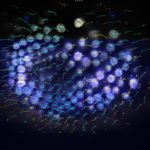Link to DOI – 10.1007/978-3-030-22386-1_4
Tinevez JY., Herbert S. (2020) The NEMO Dots Assembly: Single-Particle Tracking and Analysis. In: Miura K., Sladoje N. (eds) Bioimage Data Analysis Workflows. Learning Materials in Biosciences. Springer, Cham. https://doi.org/10.1007/978-3-030-22386-1_4
The aim of this chapter is to learn the principles and pitfalls of single-particle tracking (SPT). Tracking in general is very important for dynamic studies, as it is about propagating object identities over time, permitting the calculation of dynamic quantities such as object velocities. Tracking is often the first step in analyzing dynamics.
The output of tracking is simply tracks, and later steps involve computing relevant quantities from these tracks. In the case of the applications we use in this module, we wanted to learn something about the particles we track, which are unknown organelles (at the time of the publication) appearing transiently in cells upon stimulation by an interleukin. Namely we want to determine whether they are bound to a structure, transported or freely diffusing. To do so, the analysis is completed by performing a Mean Squared-Displacement (MSD) analysis.

